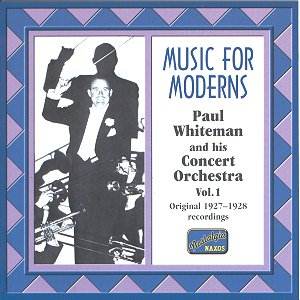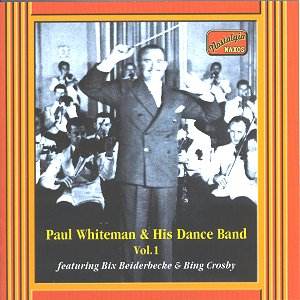 CD Reviews
CD Reviews
MusicWeb
Webmaster: Len Mullenger
Len@musicweb.uk.net
[Jazz index][Rock][Purchase CDs][ Film MusicWeb][Classical MusicWeb][Gerard Hoffnung][MusicWeb Site Map]
PAUL WHITEMAN
| Music for Moderns - Paul Whiteman and his Concert
Orchestra Vol.1
Recorded 1927-1928
NAXOS Nostalgia 8.120505
[63.28] |
Paul Whiteman and his Dance Band Vol.1
Recorded 1926-1929
NAXOS Nostalgia 8.120511
[56.53] |
 |
 |
'Pops' Whiteman is viewed as the pioneer of symphonic jazz and is probably best known, certainly by cross-over aficionados, as the man who put Gershwin's Rhapsody in Blue on the map. Born in 1890 at Denver, Colorado, (he died in Philadelphia in 1967) he trained as a boy on the violin and in his teenage years was an orchestral as well as chamber music player, but during the First World War he discovered jazz. He first fronted a small nine-piece band, then he was taken up (1922) by Victor Records and produced the hits Whispering and The Japanese Sandman which sold two million copies. His unique ability to attract the best players in their instrumental fields to his band unsurprisingly produced performances of the highest calibre; names such as Jack Teagarden, Joe Venuti, the Dorsey brothers, Hoagy Carmichael and Bix Beiderbecke were legends in their own right but played under Whiteman. They were then joined by vocalists such as Harry Lillis 'Bing' Crosby when Whiteman's New York base was extended to Broadway including such showtime hits as Ziegfeld's Follies. The first volume in the dance band series which Naxos have produced as part of their highly welcome nostalgia series is full of Crosby gems such as Mississippi Mud, Ol' Man River, Makin' Whoopee, Oh Miss Hannah, and the song more associated with Maurice Chevalier, Louise.
Transfers (whilst still retaining that evocative ambience of the period) by David Lennick are excellent, instrumental breaks (Beiderbecke's playing on eleven of the eighteen tracks of the Dance Band disc underline his tragic loss from alcohol abuse at the age of 28 in 1931) and the vocal contributions of the likes of Crosby (even in a very un-Paul Robeson version of Ol' Man River which generally lies too low for him) and the Rhythm Boys (including marvellous scat singing by Crosby, Al Rinker and Harry Barris in Changes and There ain't no sweet man that's worth the salt of my tears and Wistful and blue, the latter with one of the few piano breaks) are of the highest order. Whiteman's versatility as an orchestrator is at its best on this disc in the three purely instrumental numbers Lonely Melody, San, and Dardanella, but for witty words (and an unusually prominent part for the celesta) listen carefully to Makin' Whoopee, an anti-marriage song if ever there was one, and for instrumentation the sheer variety in I'm in love again).
In the Concert Orchestra disc (also a first volume), the spotlight falls more on Whiteman himself, and his collaborations with the likes of Gershwin, Ferde Grofé, and even Victor Herbert, who in the year before his death in 1924, wrote his Suite of Serenades for the bandleader, underline the bandleader's stature at this time. Herbert's four-movement Suite is a short characteristic but colourful work covering Spanish, Chinese, Cuban, and Oriental styles, somewhat stereotyped in approach. The trouble with it is its limited variety, Spanish and Cuban, Chinese and Oriental are in themselves related. When day is done (a Robert Katscher number) is the best on both discs, superb piano and trumpet breaks, subtle instrumentation and a catchy tune. The familiar Gershwin recording of the Rhapsody underscores his incredible pianism, though the instrument's rather distant placing (compared to the muppet-like sounds of a very prominent baritone sax at one point!) is a disappointment - this is the 1927 recording (with cuts coming in at half the full length) conducted by Victor Studio's resident maestro Nathaniel Shilkret, and well too judging by the immaculate ensemble he achieves.
Some of Whiteman's players also feature in their own right as arrangers. Rube Bloom's Soliloquy is notable for its prominent writing for flutes and the piano duettists Harry Perella and Ray Turner, Midnight reflections for Matty Malneck's unashamedly sentimental playing on the violin, still he wrote it so he should know. He features again in a more virtuosic account of his Caprice futuristic. Domenico Savino's Study in Blue has more than a passing semblance of a parody of Gershwin's Rhapsody, while Grofé (famed for his Grand Canyon Suite) orchestrated Eastman Lane's Sea Burial (a movement from a larger 1920 work called Eastern Seas) for Whiteman in 1928. Roy Bargy is the starry soloist in the 1928 recording of Gershwin's concerto (about ten minutes cut), by then three years old. A highly recommended pair of discs.
Chris Fifield